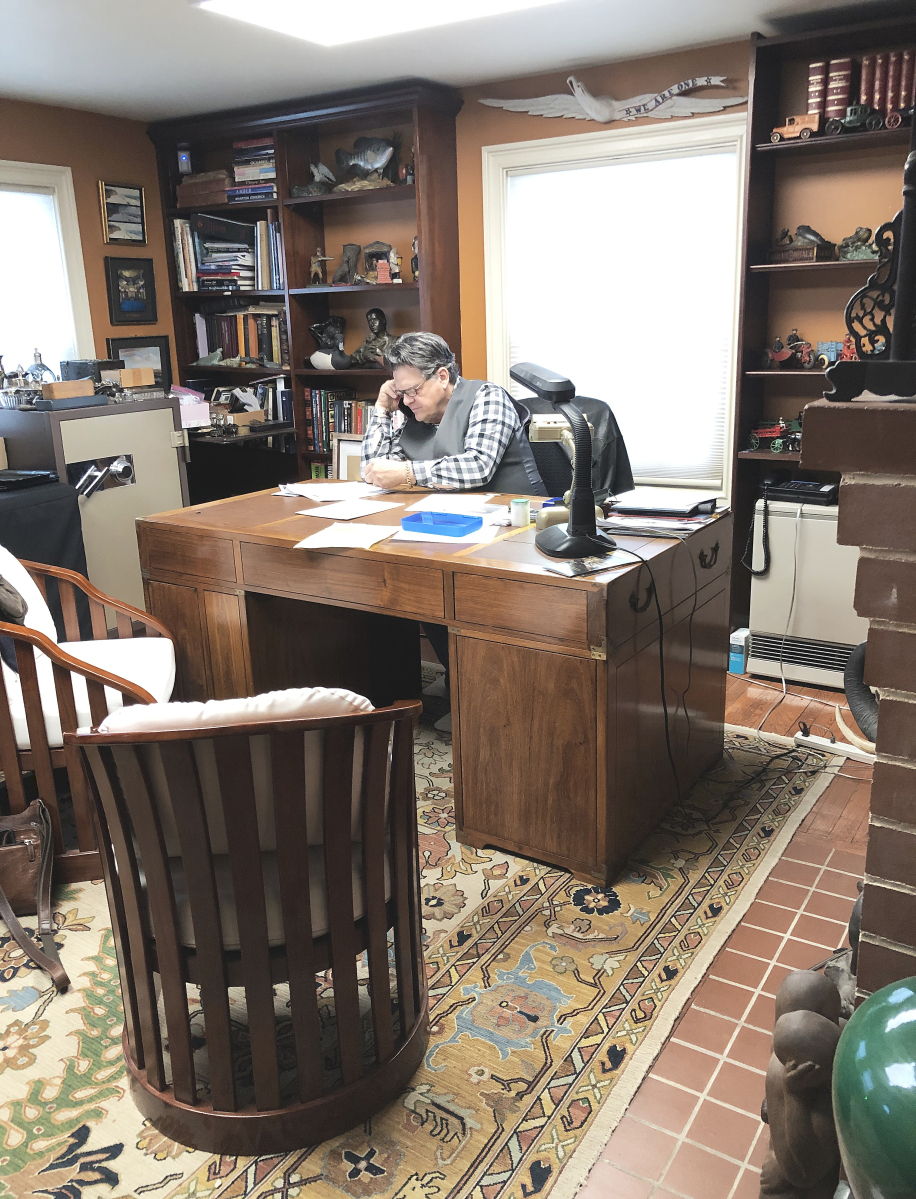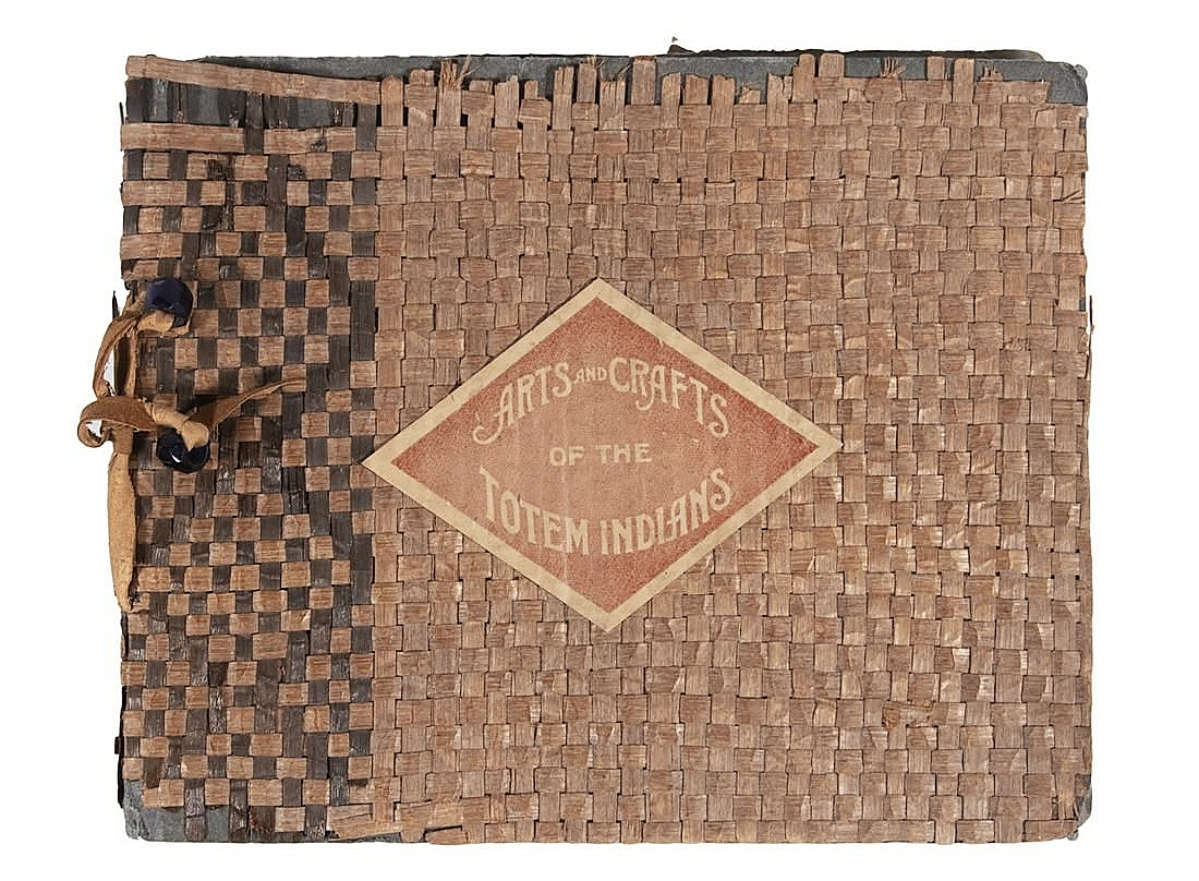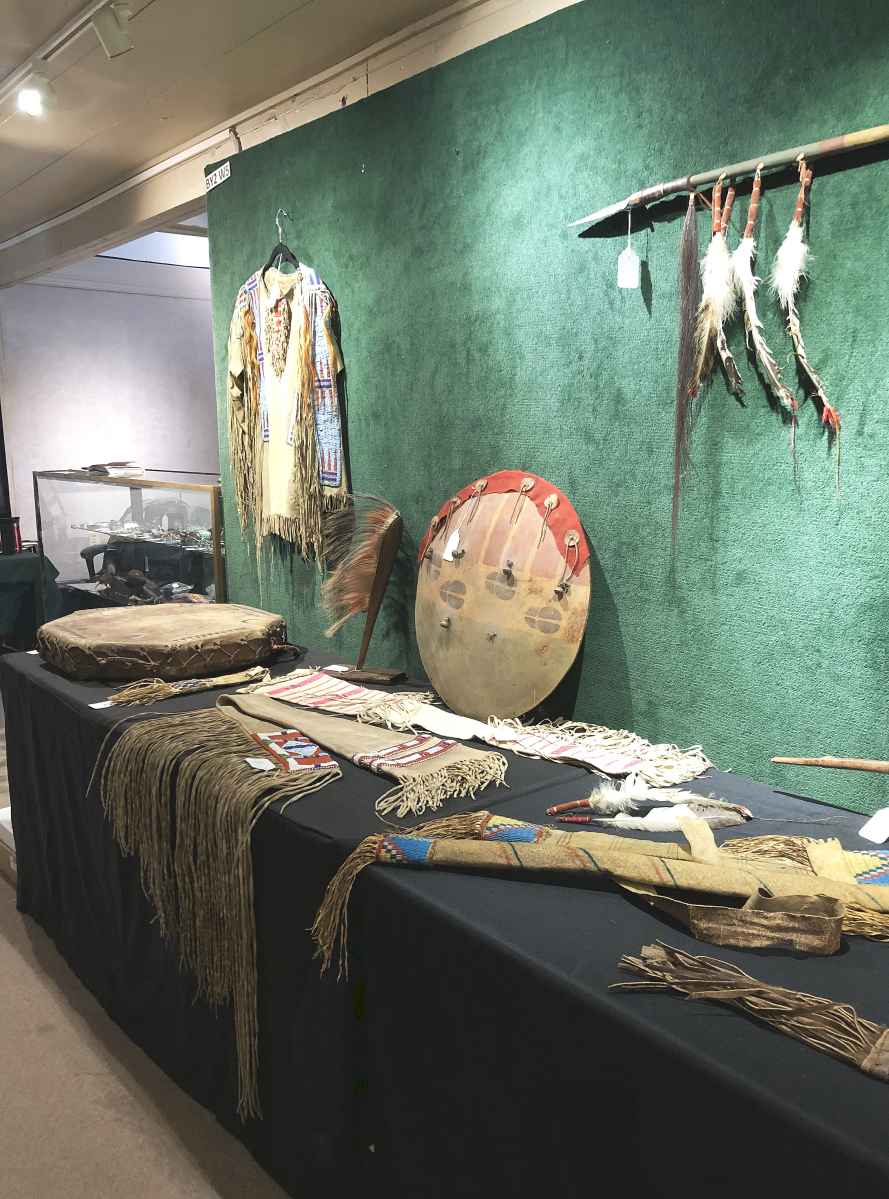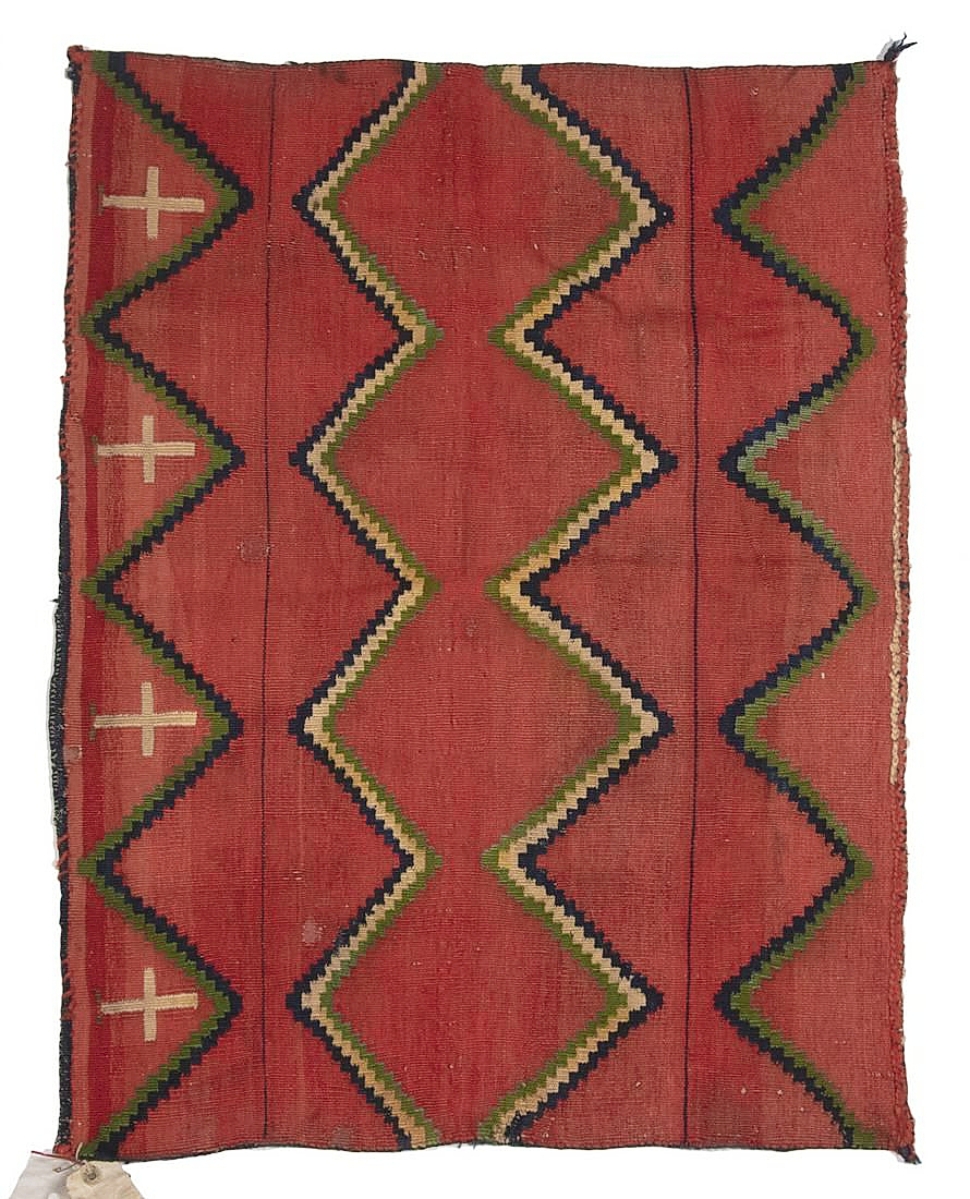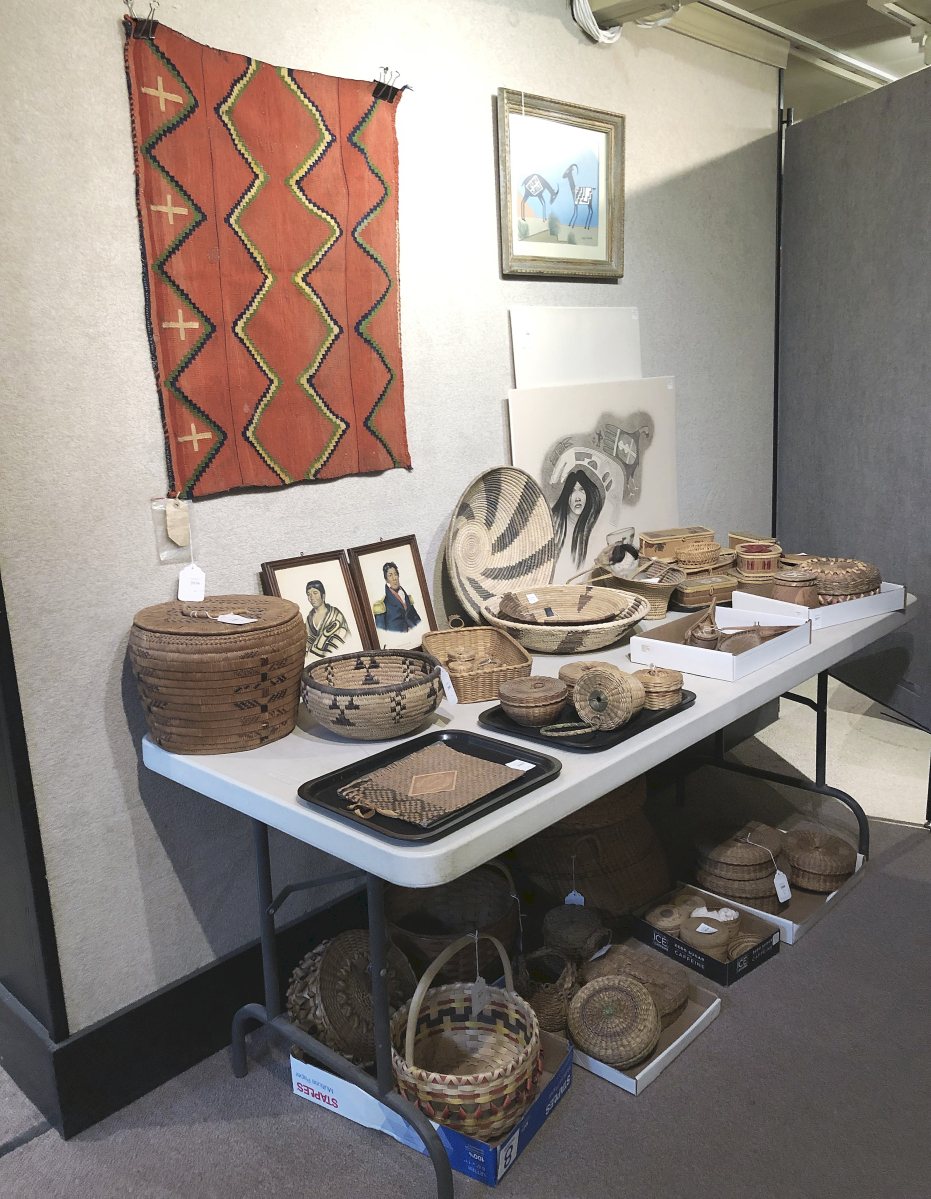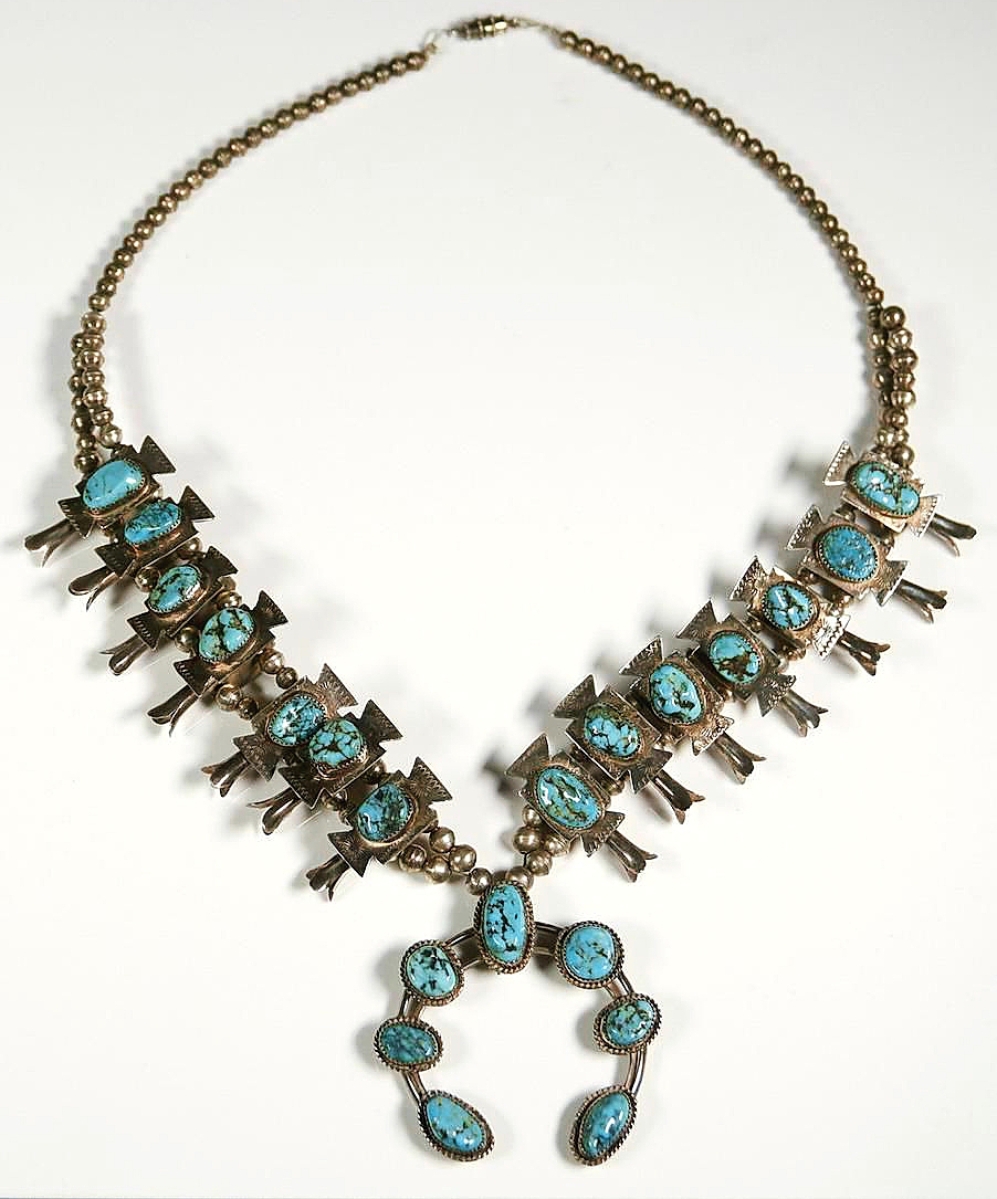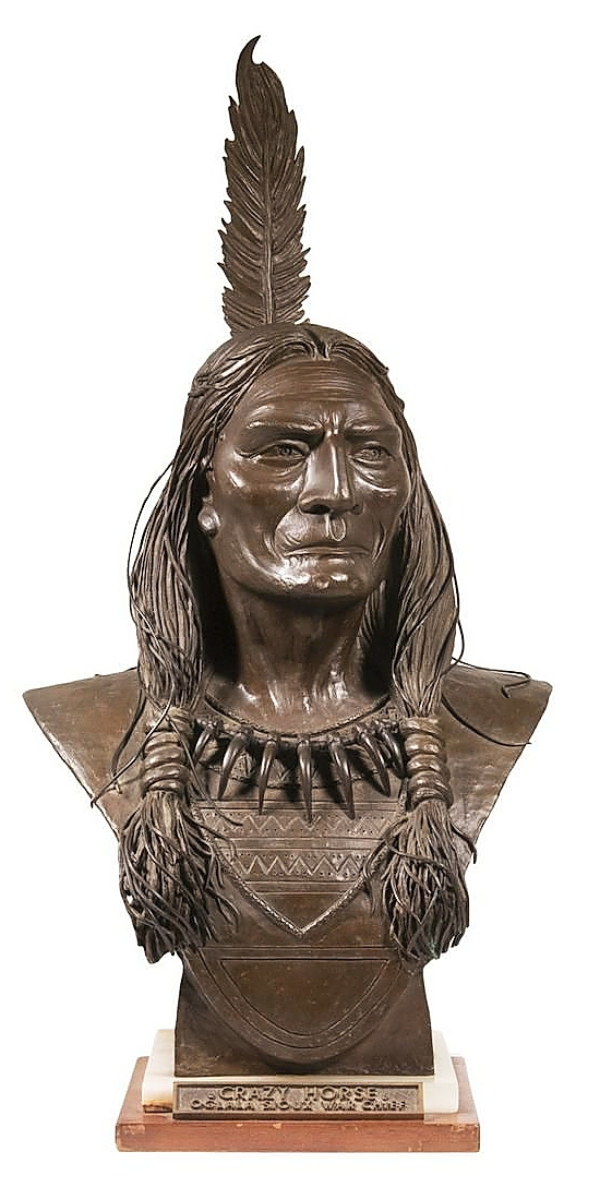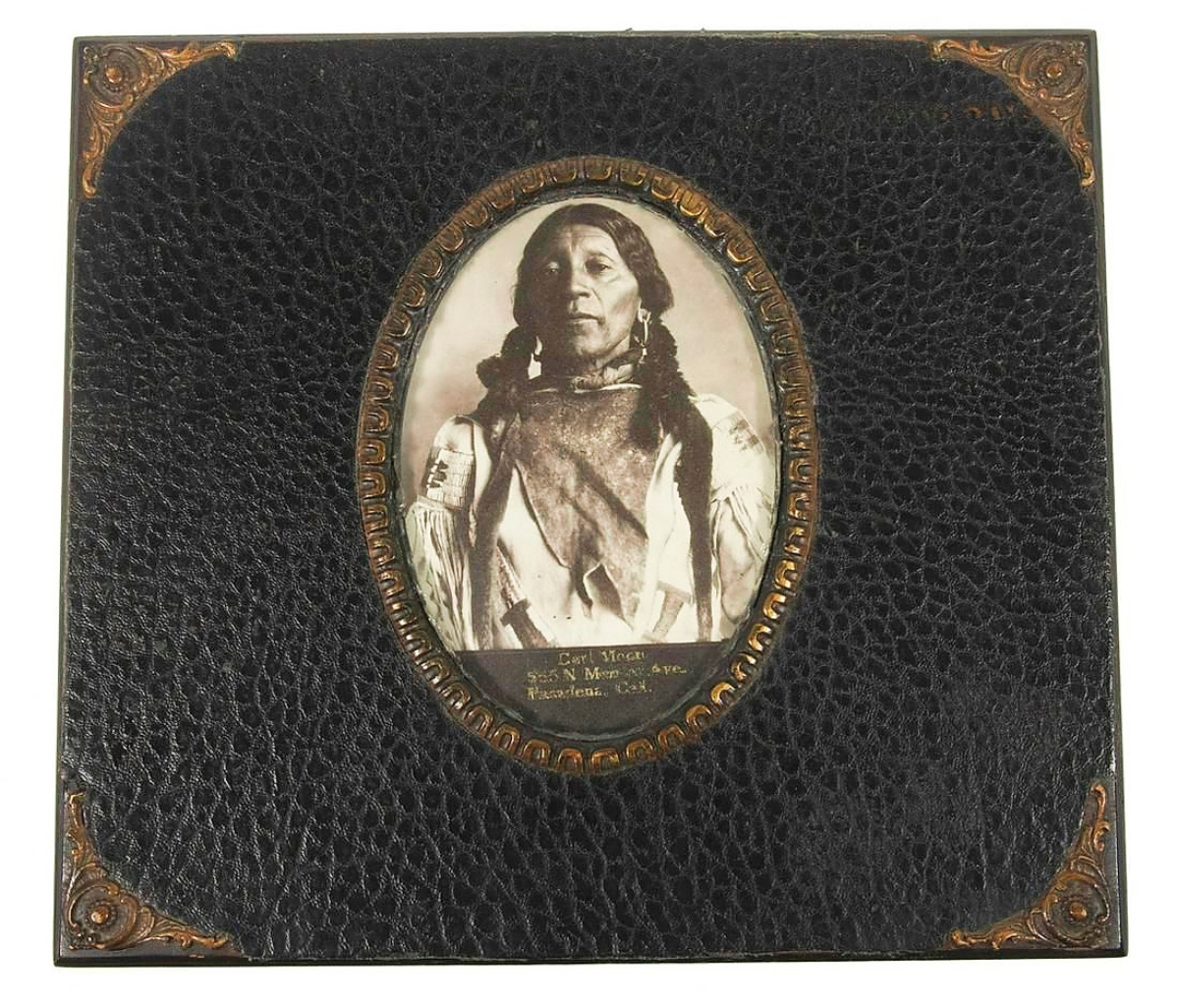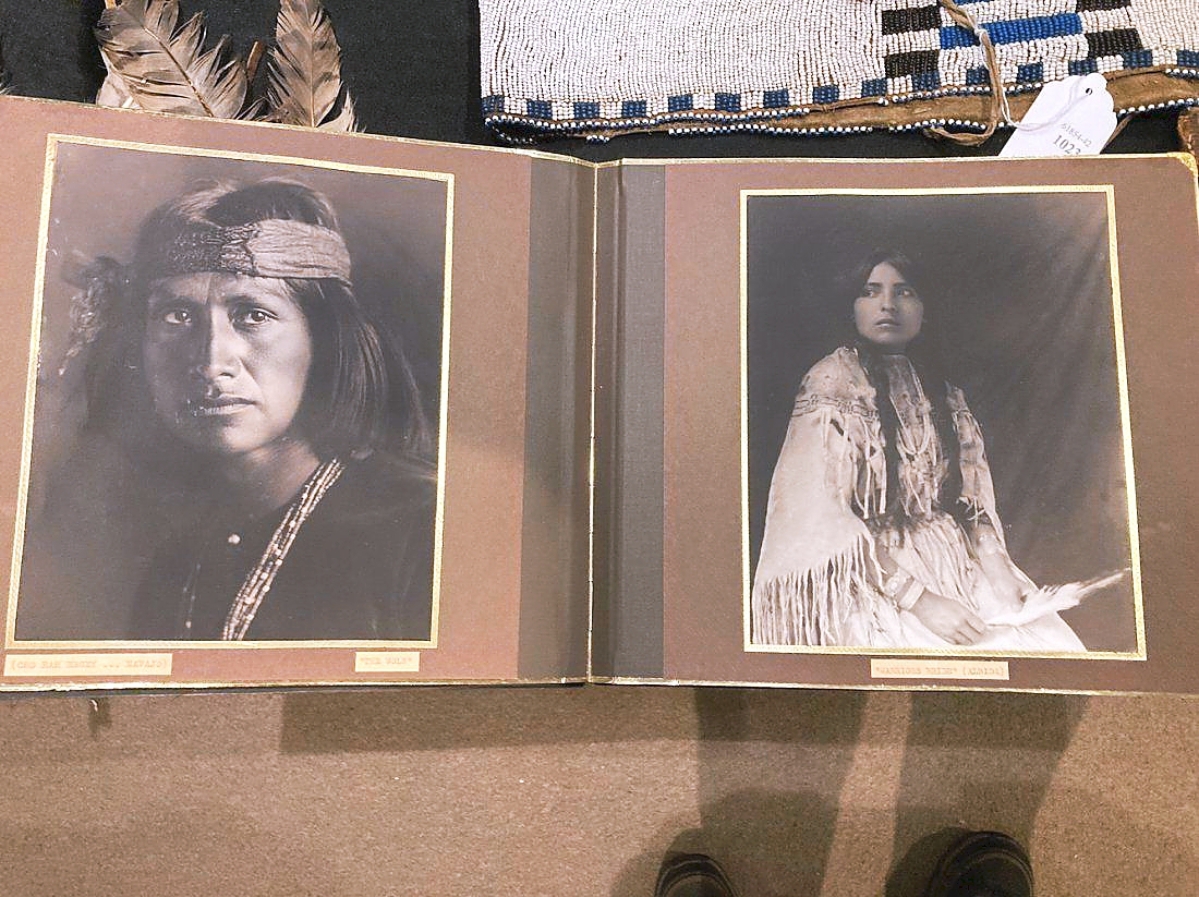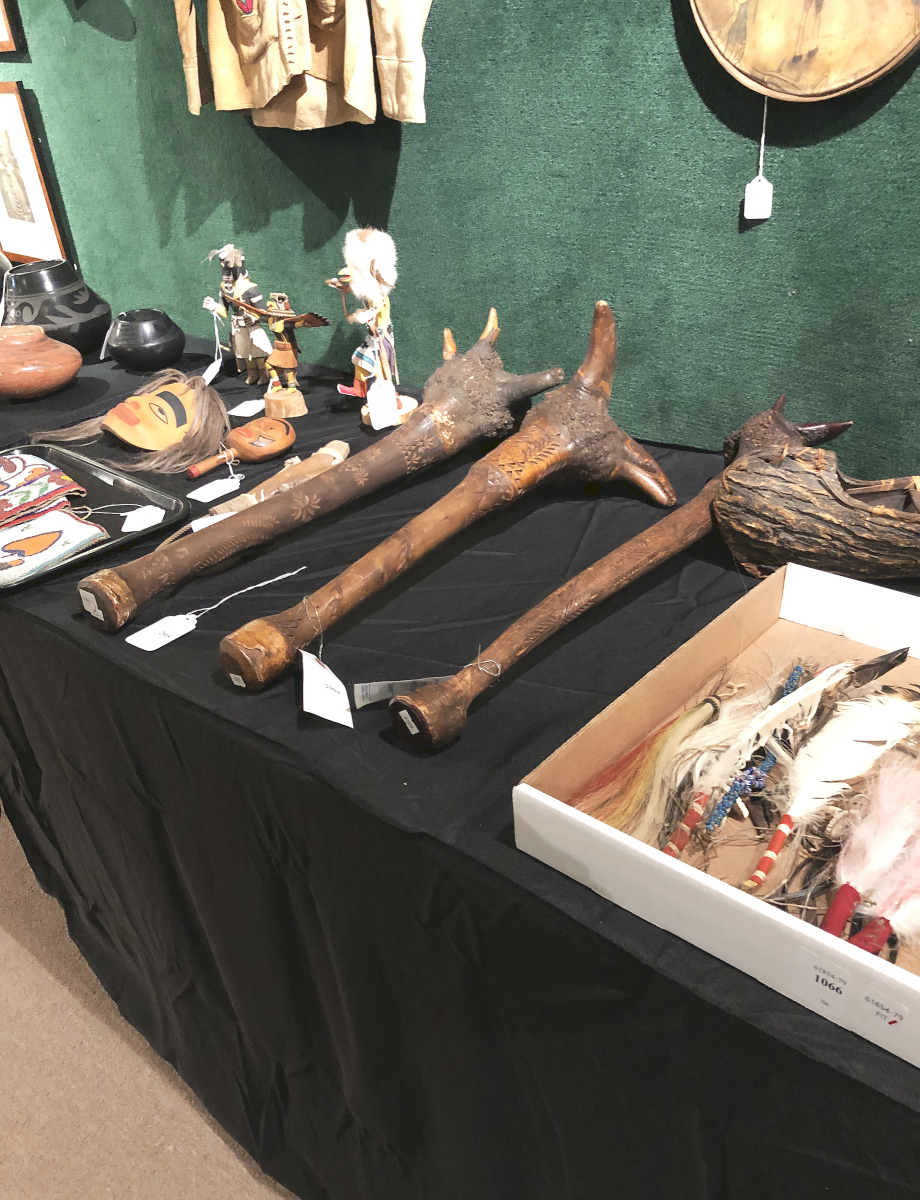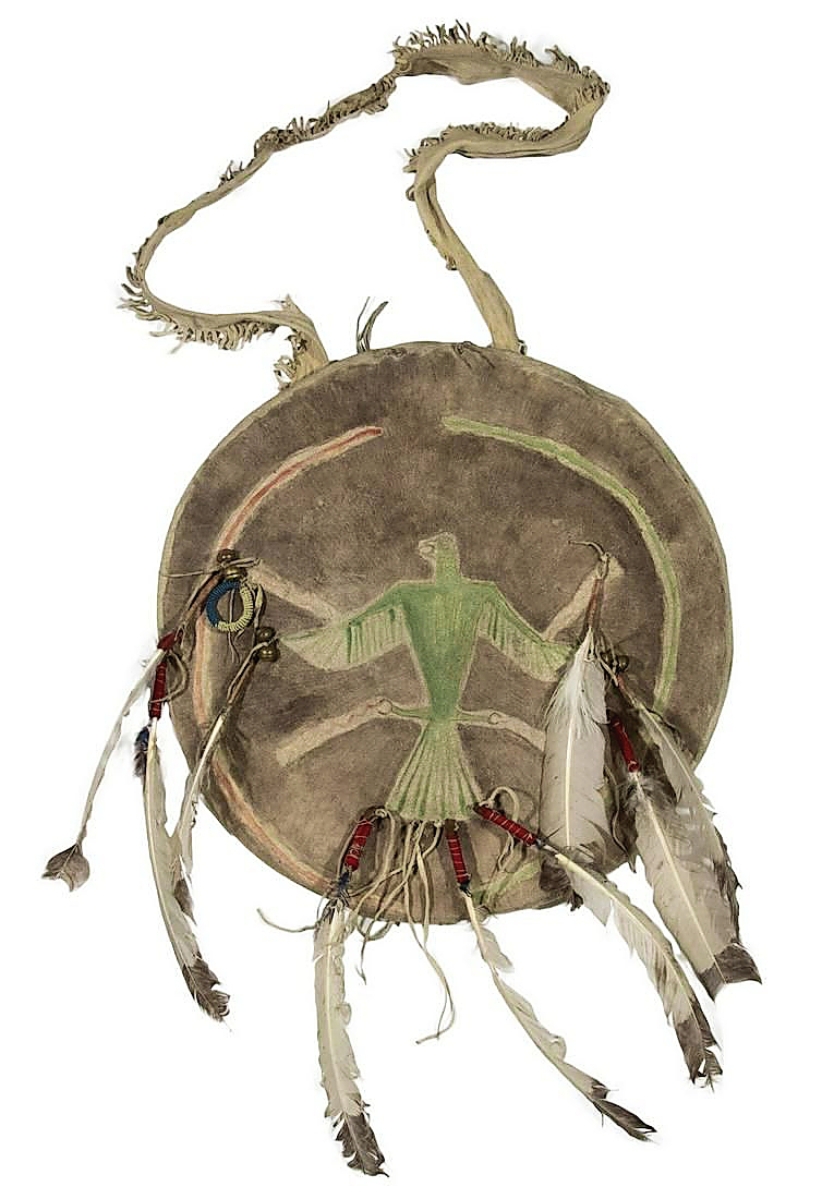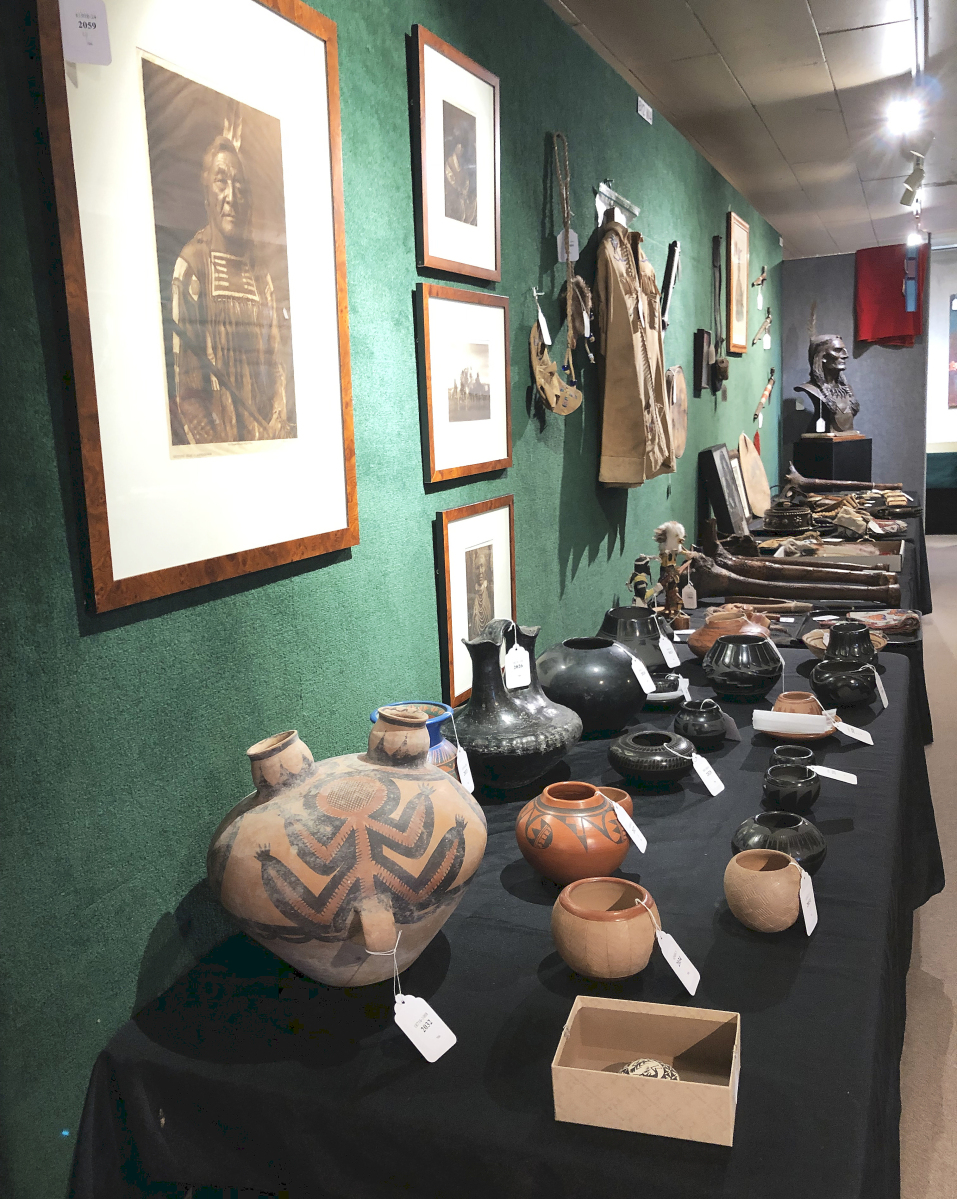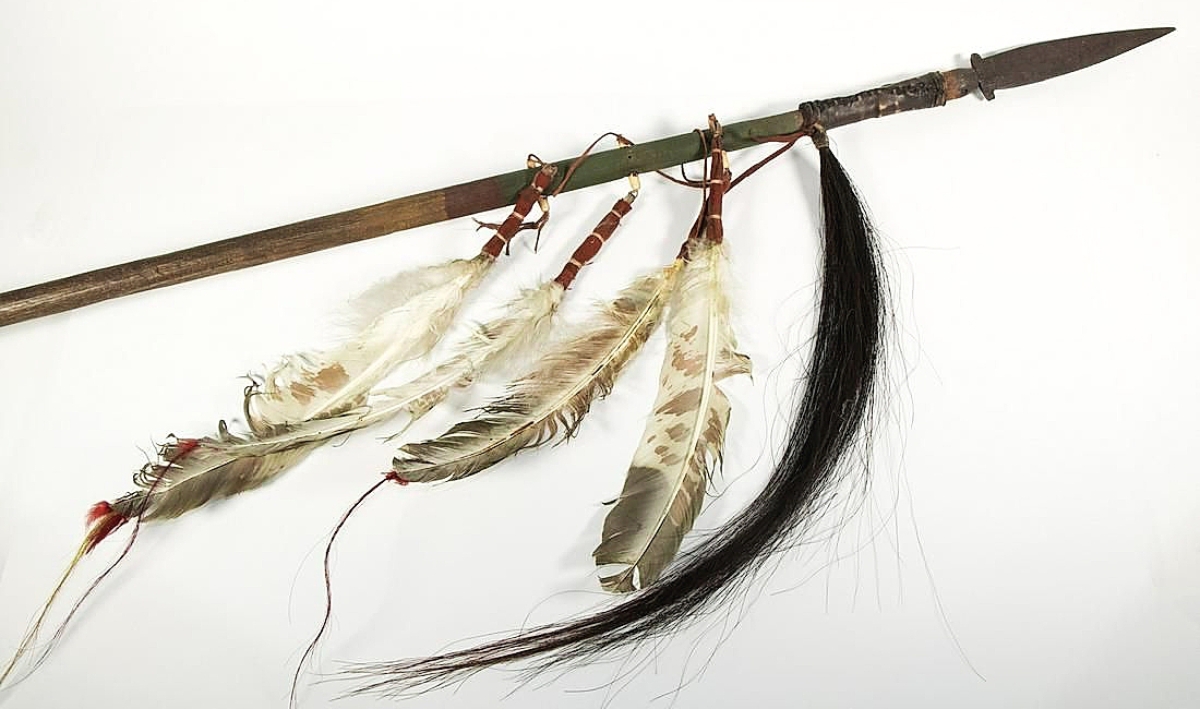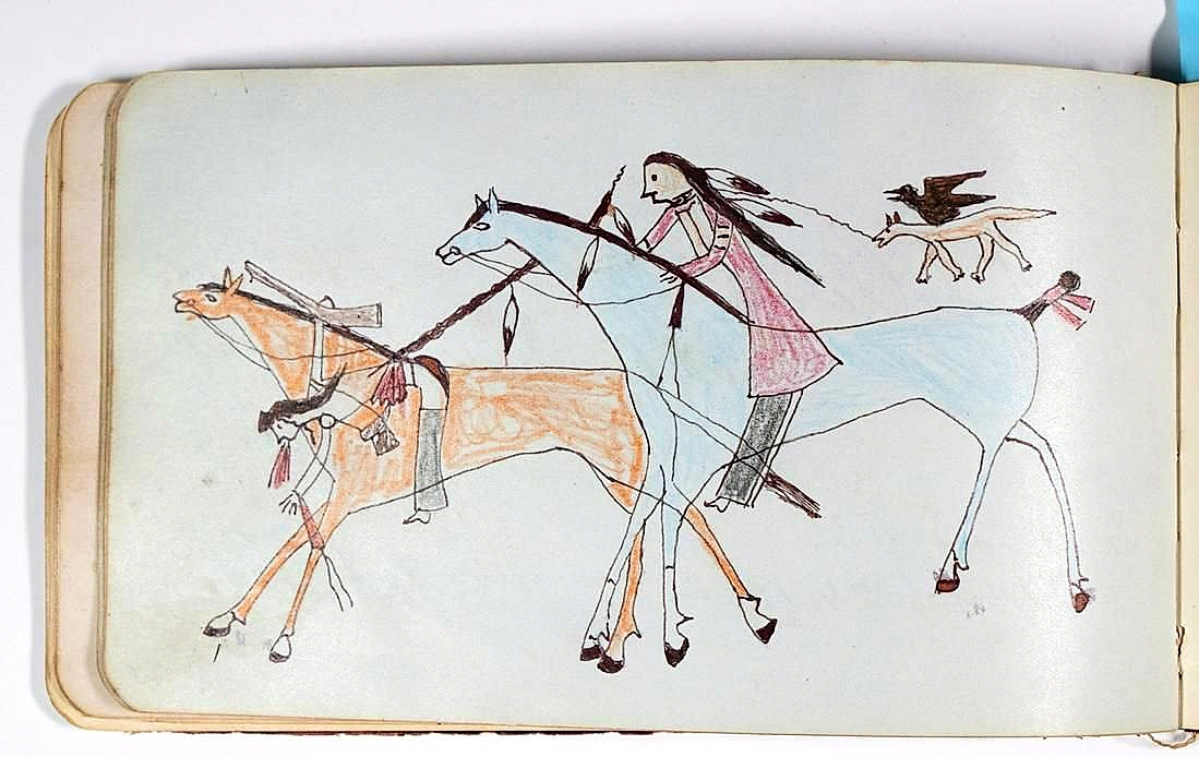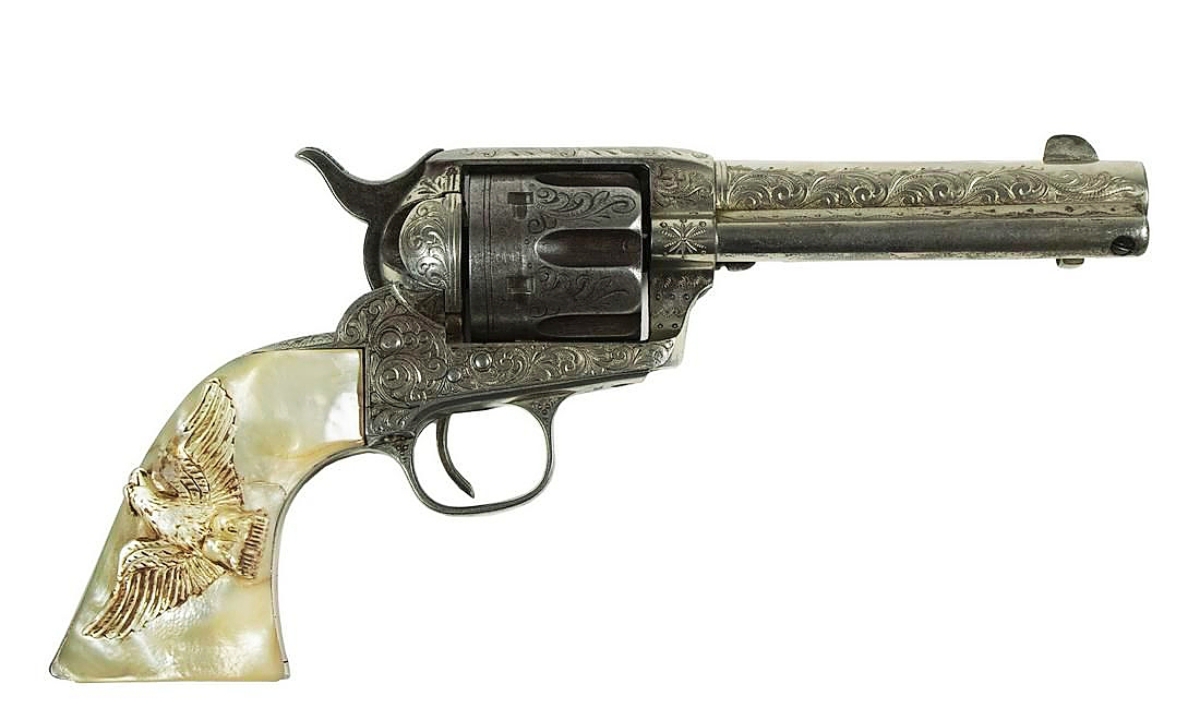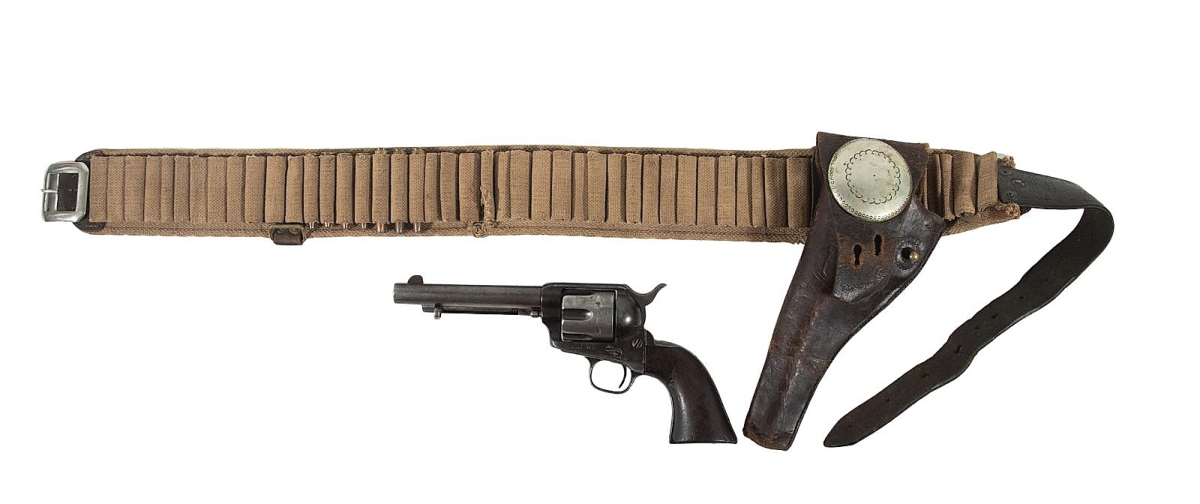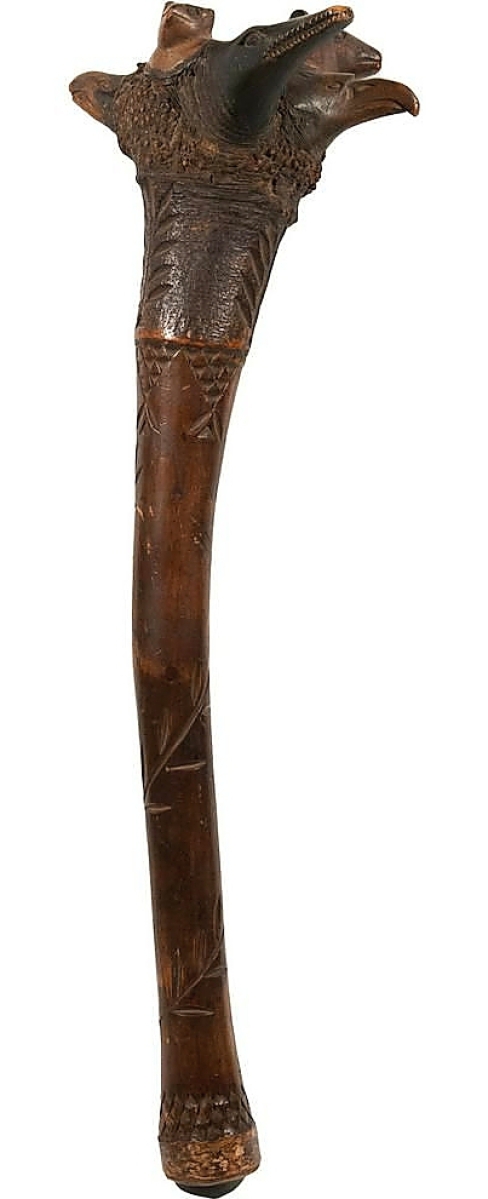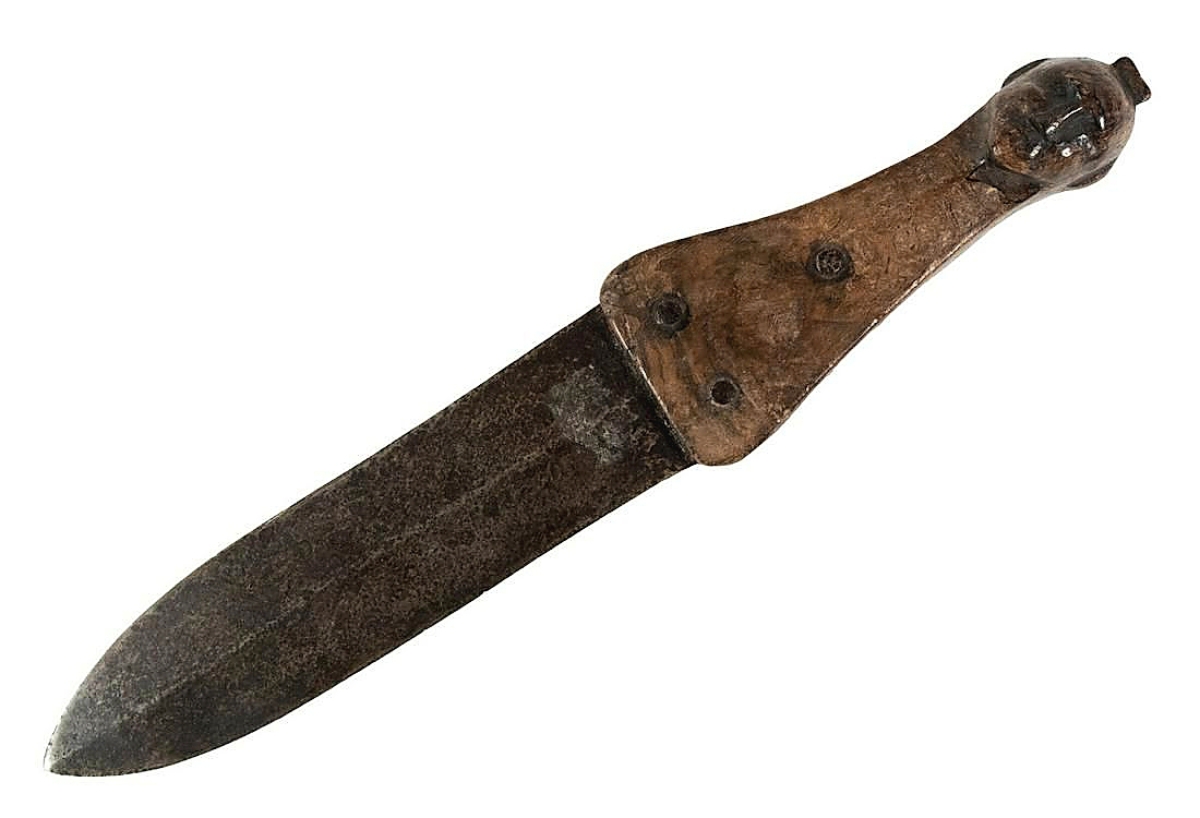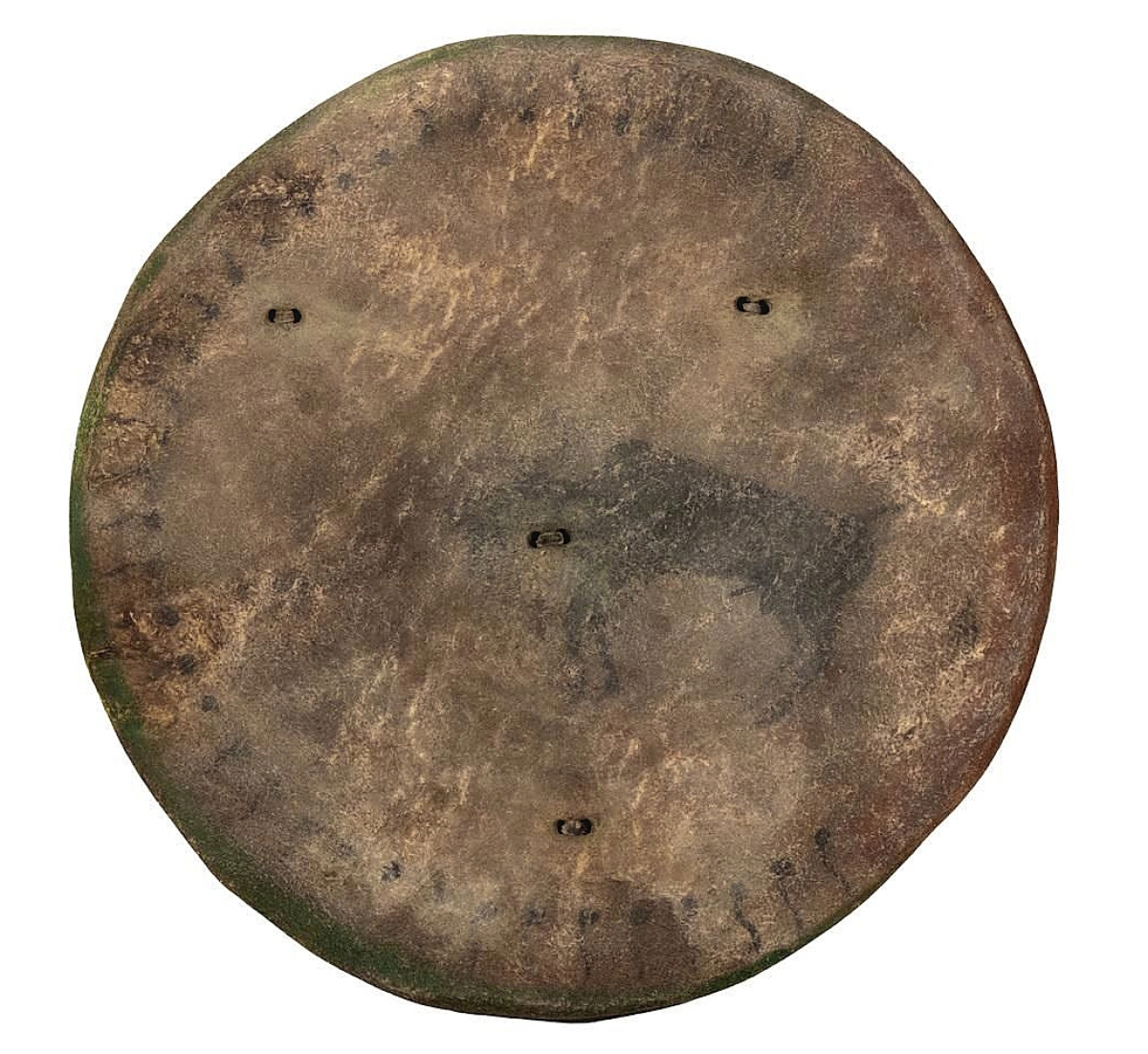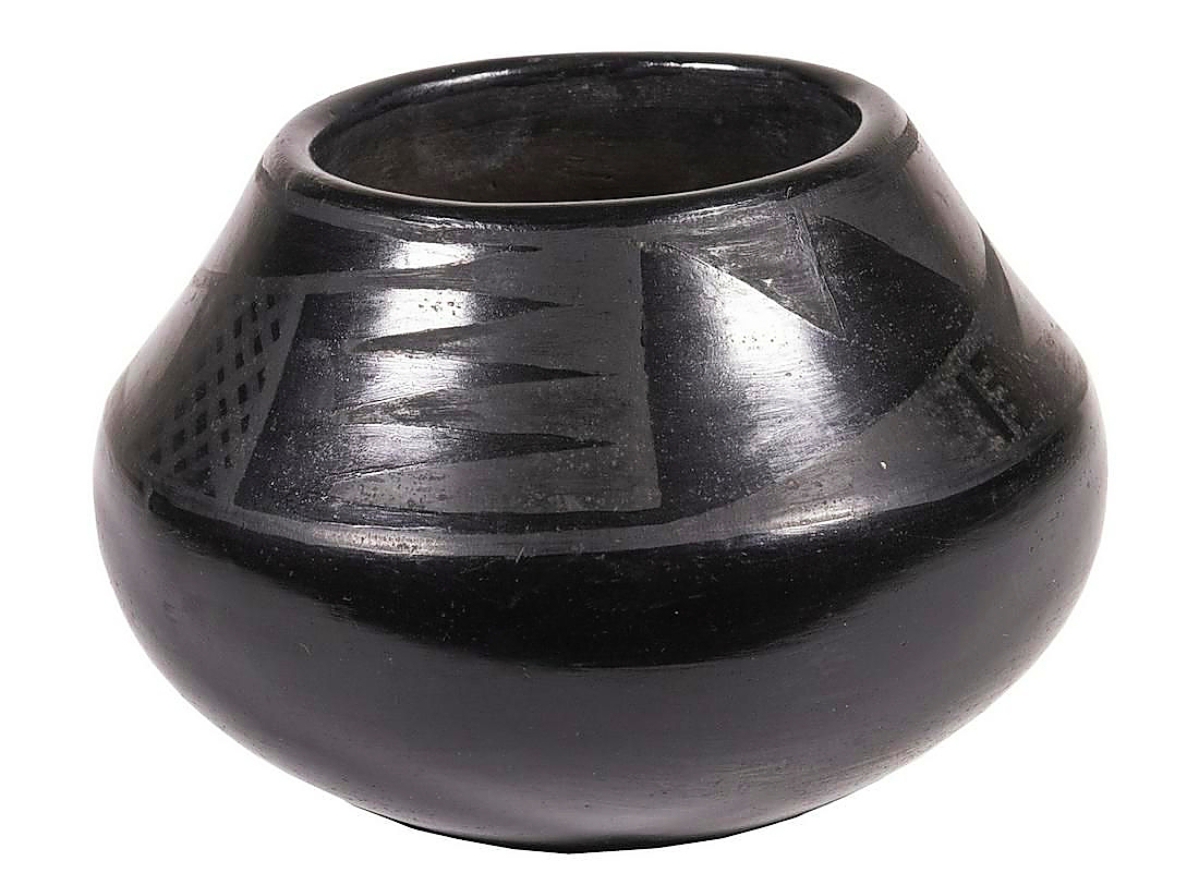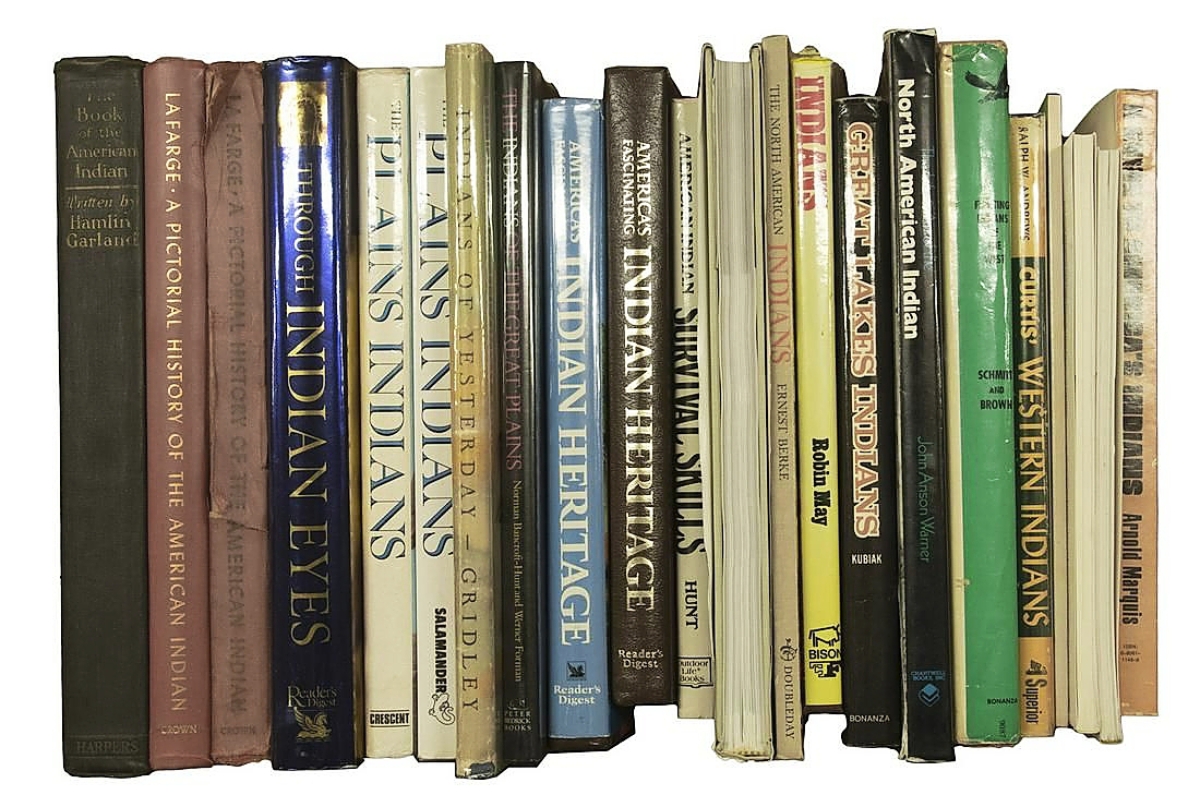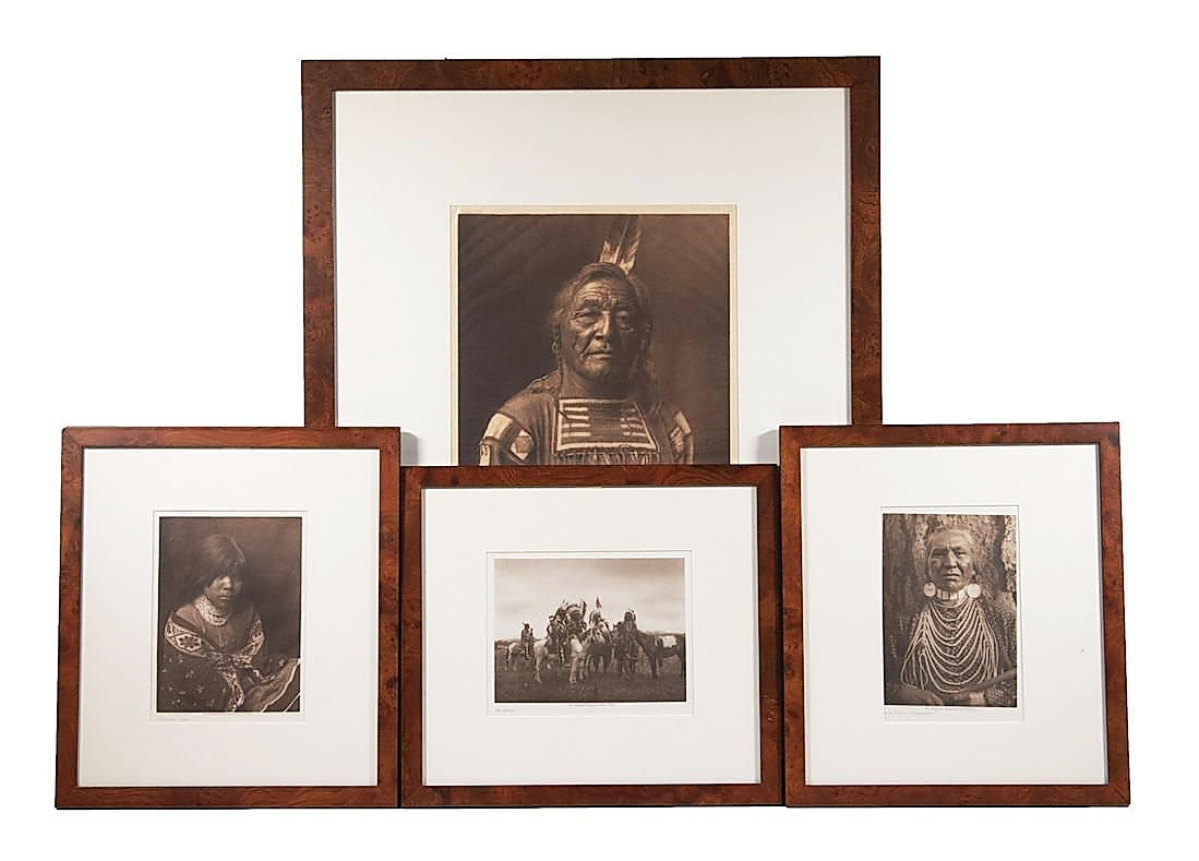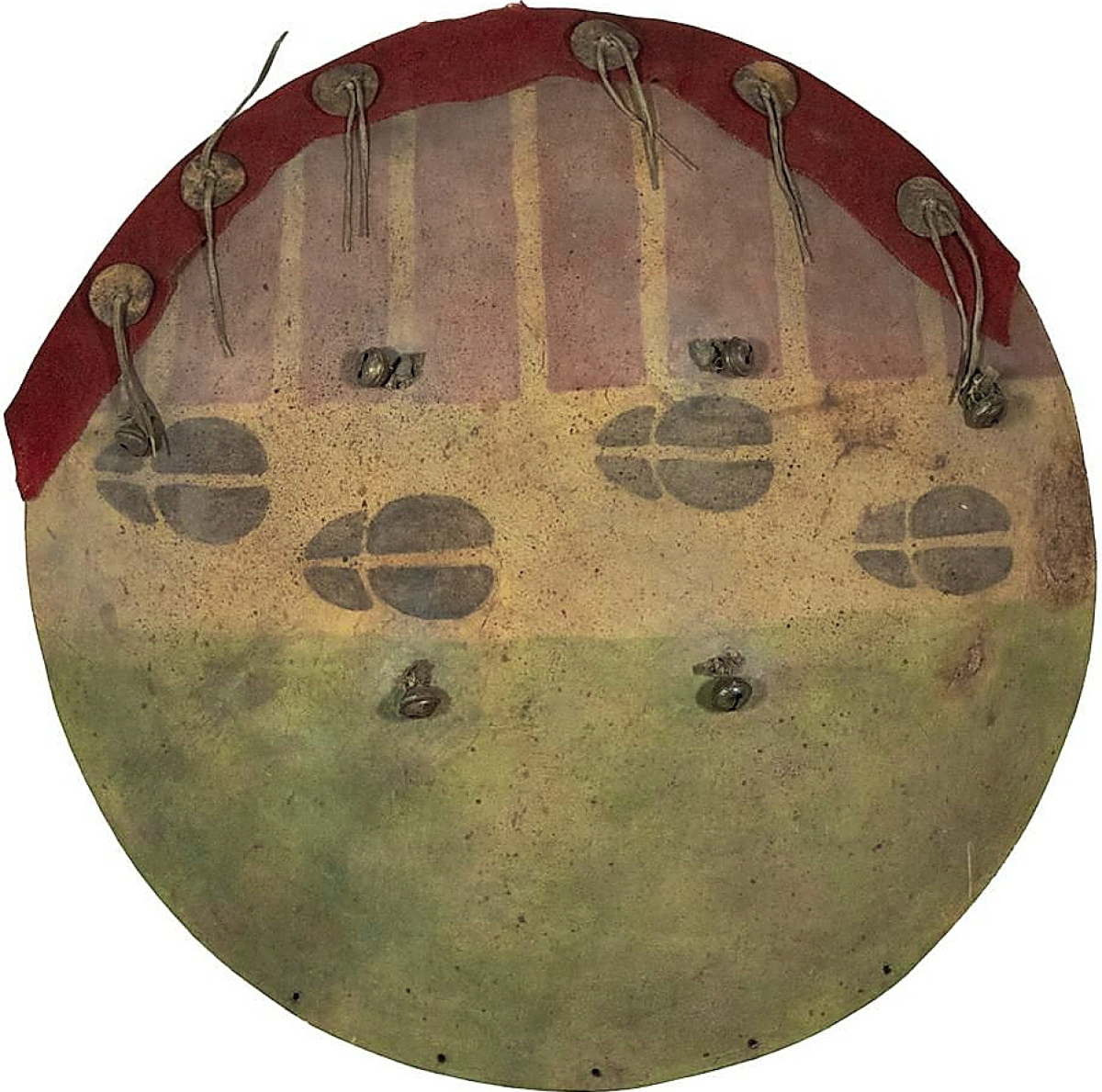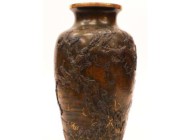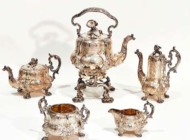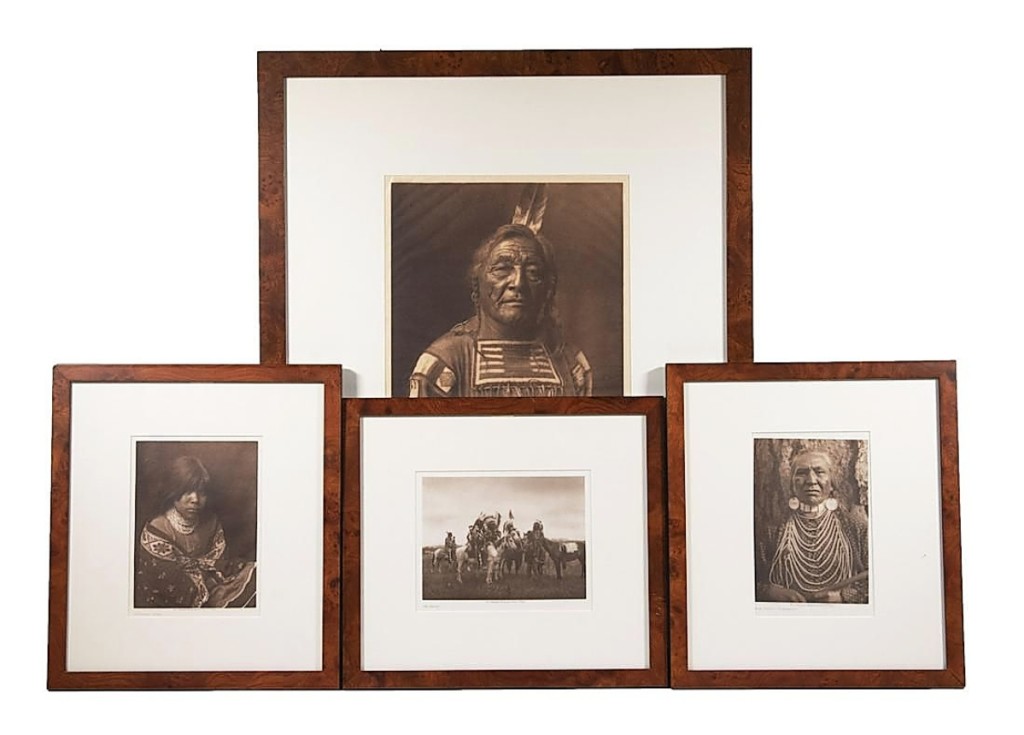
A lot of four identified sepia photogravure portraits from The North American Indian by Edward Curtis attained $2,400.
Review and Onsite Photos by Rick Russack, Additional Photos Courtesy Thomaston Place Auction Galleries
THOMASTON, MAINE – The entire January 14 sale at Thomaston Place Auction Galleries was devoted to Native American artifacts, with the first 73 lots including many items that had once been owned by Carl Moon (1878-1948), famed photographer of Native Americans of the Southwest. He was a contemporary of Edward Curtis, and the quality of his images and their content – the way of life they depict – are comparable to Curtis’ work. Moon often lived for weeks at a time in Navajo villages and collected numerous artifacts relating to Plains tribes in the period between the Battle of Little Big Horn and the US Army’s massacre of Indians at Wounded Knee. Many of the items in this sale relate to those disasters, as well as many items relating directly to well-known Indian chiefs. Also included was an album of 40 photographs Moon took, all identified. The well-advertised sale was live-streamed on three platforms and grossed $337,000.
Thomaston Place is one of the few auction galleries still producing detailed, full-color, printed catalogs. For this sale, much of the catalog and history was provided by Dave Fletcher, who has written extensively on Maine history, and he also provided a 14-minute YouTube video, viewed about 400 times, describing the artifacts in the collection as well as providing the historical context for them. Two of the items in the collection were of particular interest to the Mniconjou Lakota Sioux. Kaja Veilleux, owner of the gallery, with the approval of the consignor, facilitated the return of Chief Spotted Elk’s .45 caliber Smith and Wesson revolver, along with his personal elk-handled knife, to the tribal elders for their collection at the Cheyenne River Sioux Reservation in South Dakota. Spotted Elk participated in the Battle of Little Big Horn and was among those slaughtered at Wounded Knee. As the story goes, this knife was removed from Spotted Elk’s frozen body by a soldier after the massacre.
The first lot in the sale was an important album of 40 photographs taken by Moon in the early years of the Twentieth Century. In 1903, just out of high school, Moon moved to Albuquerque, N.M., to begin his career as a photographer. His photographs and paintings soon came to the notice of President Theodore Roosevelt, who invited him to exhibit his work in the White House. In 1907, Moon went to work for the Fred Harvey Company, and he also worked as a photographer for the Santa Fe Railroad, producing images for both that were used in marketing brochures and advertisements. He also, with his wife, wrote and illustrated children’s books. Each of the images in the album, which sold for $12,000, were identified. His photographs are in the collections of several major museums, including the Getty and the Huntington Library, which has the largest collection of his work.
Moon also collected artifacts, mostly of Plains Indians, and several were included in this sale, one of which brought the highest price of the day at $38,400. This was an early, pre-reservation period war shield that had belonged to Buffalo Hump, a war chief of the Penateka band of the Comanches. It was a gift from a descendant to Moon, who displayed it in his studio. Decorated with buffalo tracks, it was the type of personal object that was usually buried with its owner. This shield was discussed in In Search of the Wild Indians by Tom Driebe.
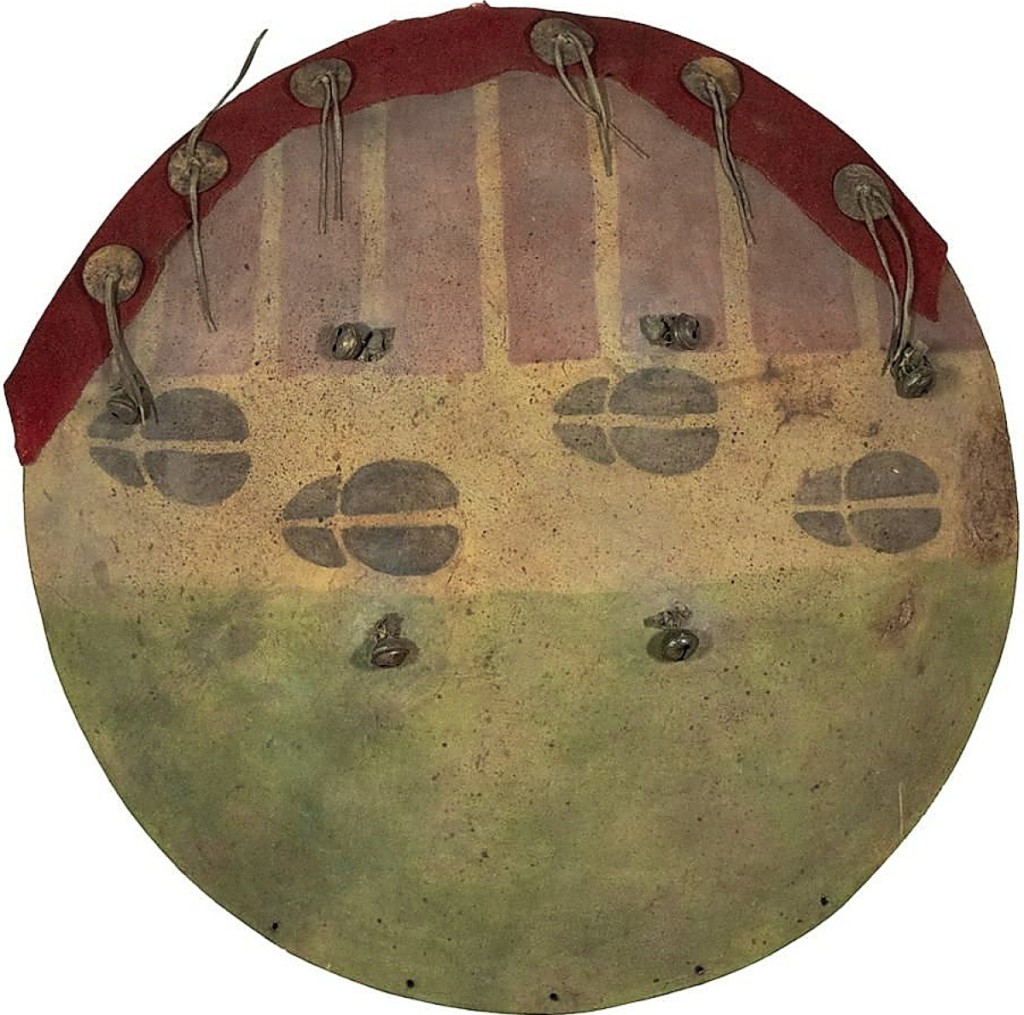
This war shield brought the highest price of the day, $38,400. It had belonged to Buffalo Hump, a war chief of the Penateka band of the Comanches. It was one of the items that Carl Moon had collected on his travels in the Southwest and had been displayed in his studio.
The sale included numerous other items of historical importance. A child-sized Kentucky rifle that had been given by Abraham Lincoln to his son, Robert Todd Lincoln, on his 12th birthday sold for $30,000. The stock bore a later engraving, “My Dearest Son, Robert Todd Lincoln, Happy 12th Birthday, August 2, 1855.” It first appeared on the market in 1945, with full provenance, which was included. The 41-inch gun had been made by Philadelphia gunsmith Joseph Golcher. A Penobscot chief’s war club dating to 1795 with carved figures of a bear, eagle, turtle, pike and owl sold for $18,000. It was displayed in the Smithsonian in 1971, and the accompanying documentation included a 1918 publication by the Essex Institute of Salem, Mass., which recounts the story of the “Chief’s Sceptre Club” as belonging to “An Indian man who was barborously (sic) shot by some murderous persons.” Two of the murderers were later captured, and one was executed for the crime. An 1881 pictograph by Crow Dog illustrated a scene from his trial for the killing of Lakota chief Spotted Tail. The drawing was found in 2000 in one of three albums stored in the jail office in Deadwood, S.D. It brought $9,000. The album included the signatures of several of the men who were involved in the trial.
The sale also included a wide selection of other Native American material, including, rugs, pottery, turquoise jewelry and more. A dated 1792 silver Peace medal, engraved on one side with George Washington receiving a peace pipe from an unidentified chief and the US seal on the other side, sold for $7,800. There were a number of weavings, and topping the group, selling for $4,800, well over the estimate, was a circa 1860 Navajo horse blanket, in vibrant shades of green, white and black on a red background. A circa 1900 “eye-dazzler” Navajo rug earned $2,280, and a large Navajo chief’s blanket with red, blue and ivory stripes finished at the same price.

Abraham Lincoln gave this child-sized rifle to his son, Robert Todd Lincoln, on his 12th birthday and it sold for $30,000. The stock bore a later engraving, “My Dearest Son, Robert Todd Lincoln, Happy 12th Birthday, August 2, 1855.”
There were a number of weapons, both with tribal provenance and Army-issued weapons. Foremost, bringing $7,800, was a Plains war lance/spear dating to the 1870s or earlier. The catalog stated, “Representative of the Kiowa, Comanche or Southern Cheyenne design of the early Indian Wars. The entire shaft is painted with green and red pigment, the hand-forged spear point is attached by heavily patinated sinew.” A circa 1850 Blackfeet effigy knife reached $4,200. The wooden handle featured a round-carved human head. A knife described as a Blackfeet woman’s knife, made from the jawbone of a coyote (with teeth still attached), sold for $1,320. Leading the Army-issued weaponry was an engraved 1883 Colt model 1873 revolver. The mother-of-pearl handles were carved with a steer head, and the gun sold for $7,800. Neither Army nor tribal was an 1886 Colt revolver with a fancy leather holster and gun belt that had belonged to MGM Studios. It reached $3,900 and came with a studio brass tag.
The day before the sale, we had a chance to spend some time with Kaja Veilleux, owner of the company, who discussed how he got started in the antiques business. “This is my 50th year in business,” he said. “It all began when I was a teenager working in my grandfather’s grocery store. I was intrigued by the coins I was handling every day and asked if I could keep them. The answer was yes, but I had to replace the value of the coins I was keeping. In addition to the grocery store, my grandfather would buy and sell stuff from old houses, and much of what he sold had simply been abandoned. I went with him on weekends and loved it. Soon, I started doing the same thing – buying and selling – and I got to know all the antiques dealers in the area. I was working in an art supply store for $60 a week and had the chance to buy the entire contents of a house for $1,000. But I didn’t have $1,000. I went to the bank to borrow the money and told them I just wanted it for the weekend, saying I’d repay it on Monday. I was just a kid, and the bank said they don’t do that sort of lending. So, I asked my boss for the money on a Friday and promised to repay him on Monday. He was skeptical but gave me the money. I bought the stuff, sold it over the weekend to the dealers I knew and repaid the loan on Monday. But I earned about $1,000, and it didn’t take me long to compare that $1,000 to my $60 a week salary. So, I resigned, and I’ve been buying and selling ever since. People ask when am I going to retire, and my answer is never – this is too much fun. And last year 2021, the auction business was the best year I ever had, grossing $12 million. And this year could be even better, depending on what we have to sell.”
Prices given include the buyer’s premium as stated by the auction house. For information, www.thomastonauction.com or 207-354-8141.

